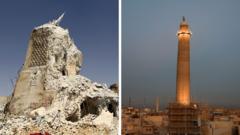The historic city of Mosul, once a beacon of cultural tolerance, is witnessing a remarkable revival after years of destruction initiated by the Islamic State (IS). Following its liberation in 2017, a comprehensive restoration project aimed at rebuilding the city’s iconic structures has been launched, led by Unesco.
On Wednesday, a ceremony will celebrate the reopening of these pivotal landmarks, attended by Unesco's director-general, Audrey Azoulay, and Iraqi Prime Minister Mohammed Shia' al-Sudani, along with local artisans and various religious representatives uniting in this moment of revival.
The upheaval began in 2014, when IS seized Mosul, a city that had long symbolized co-existence among diverse communities. The extremist group’s reign resulted in dire consequences, with mass killings and the targeting of religious minorities. Their control was finally breached three years later through a coalition offensive. The remnants of the city painted a haunting picture, with the once-renowned al-Hadba minaret – a symbol of Mosul – lying in ruins.
Ali al-Baroodi, a photographer, recounted the devastation: "It was like a ghost town," remembering the sight of the city stripped of its identity. An overwhelming 80% of the Old City was left in tatters following the violent occupation by IS, necessitating both physical rebuilding and the restoration of communal bonds deeply rooted in its rich history.
Supported by a budget of $115 million – sourced largely from the United Arab Emirates and the EU – the recovery efforts have prioritized collaboration among the various religious and ethnic communities in Mosul. Father Olivier Poquillon, leading the restoration of the Dominican convent in Mosul, stressed the importance of rebuilding trust between disparate groups as the foundation for reconstructing the city’s physical spaces.
Maria Rita Acetoso, the project’s chief architect, emphasized the restoration's broader implications, showcasing how cultural initiatives can revitalize local economies and foster skills development. Her vision highlights the significance of this effort in restoring a sense of identity, particularly for younger generations growing up in conflict.
The restoration project has witnessed the training of over 1,300 local youths in traditional crafts and the creation of approximately 6,000 jobs, reinforcing community ties through shared efforts. Landmarks such as al-Tahera Church have been fully restored, with bell towers ringing once more across Mosul.
Residents are gradually returning to their ancestral homes, including families like Mustafa's, whose house, dating back to 1864, has been lovingly restored. “I was very pleased and excited to see my house rebuilt again,” he shared, reflecting a communal sense of renewal.
As Mosul rises from the rubble, the city’s transformative journey is likened to a resurrection: "It’s truly like seeing a dead person coming back to life," al-Baroodi reflects, capturing the essence of hope and resilience that now envelops Mosul as its inhabitants strive together to reclaim their heritage.
On Wednesday, a ceremony will celebrate the reopening of these pivotal landmarks, attended by Unesco's director-general, Audrey Azoulay, and Iraqi Prime Minister Mohammed Shia' al-Sudani, along with local artisans and various religious representatives uniting in this moment of revival.
The upheaval began in 2014, when IS seized Mosul, a city that had long symbolized co-existence among diverse communities. The extremist group’s reign resulted in dire consequences, with mass killings and the targeting of religious minorities. Their control was finally breached three years later through a coalition offensive. The remnants of the city painted a haunting picture, with the once-renowned al-Hadba minaret – a symbol of Mosul – lying in ruins.
Ali al-Baroodi, a photographer, recounted the devastation: "It was like a ghost town," remembering the sight of the city stripped of its identity. An overwhelming 80% of the Old City was left in tatters following the violent occupation by IS, necessitating both physical rebuilding and the restoration of communal bonds deeply rooted in its rich history.
Supported by a budget of $115 million – sourced largely from the United Arab Emirates and the EU – the recovery efforts have prioritized collaboration among the various religious and ethnic communities in Mosul. Father Olivier Poquillon, leading the restoration of the Dominican convent in Mosul, stressed the importance of rebuilding trust between disparate groups as the foundation for reconstructing the city’s physical spaces.
Maria Rita Acetoso, the project’s chief architect, emphasized the restoration's broader implications, showcasing how cultural initiatives can revitalize local economies and foster skills development. Her vision highlights the significance of this effort in restoring a sense of identity, particularly for younger generations growing up in conflict.
The restoration project has witnessed the training of over 1,300 local youths in traditional crafts and the creation of approximately 6,000 jobs, reinforcing community ties through shared efforts. Landmarks such as al-Tahera Church have been fully restored, with bell towers ringing once more across Mosul.
Residents are gradually returning to their ancestral homes, including families like Mustafa's, whose house, dating back to 1864, has been lovingly restored. “I was very pleased and excited to see my house rebuilt again,” he shared, reflecting a communal sense of renewal.
As Mosul rises from the rubble, the city’s transformative journey is likened to a resurrection: "It’s truly like seeing a dead person coming back to life," al-Baroodi reflects, capturing the essence of hope and resilience that now envelops Mosul as its inhabitants strive together to reclaim their heritage.




















